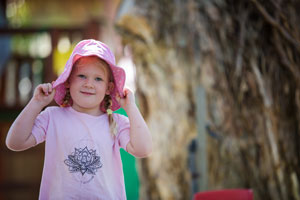
The days are getting longer and the temperatures higher.During Queensland’s extreme summer heat, early childhood services need to keep children safe from the dangers of the sun and high temperatures.
As the change of season fast approaches, there is no better time for early childhood services to ensure there are reasonable
sun protection policies and procedures (PDF, 245KB) in place.
This includes protecting children from the risks of overheated play equipment and surfaces.
While it is up to each service to risk assess its premises and equipment, the following information may assist approved providers, nominated supervisors and educators to meet their obligations to protect children from harm, including serious burns.
Shaded areas
Being outdoors, children can enjoy more complex physical activities. To accommodate these activities, the regulations require that children must have more than double the minimum space outdoors that they have indoors, as per the
unencumbered indoor and outdoor space guidance.
Creating effective shade should be considered as 1 strategy within a comprehensive sun safety policy.
Well designed and effective shade not only provides sun protection, it will also help to cool the grounds and reduce heat.
There are many ways outdoor spaces can provide shade, including shade sails, large trees and natural surfaces which reflect less UV (e.g. natural grass, soil, bark).
Natural shade in the form of well planted trees and shrubs can provide shade and help to improve the natural environment at the same time.
Additionally, wearing hats, appropriate protective clothing and sunscreen offer important protection.
Play equipment and other surfaces
During the hotter months, playground equipment and surfaces can heat up rapidly and retain heat, which is a serious burns risk to children.
The following 5 practice tips may assist in preventing scalds and burns from overheated play equipment and other objects:
- Regularly check the temperature of outdoor facilities and equipment on hot, sunny days to see if they are safe for children to use. This is crucial for surfaces that children may touch, kneel, sit or lie on.
- Make sure all equipment and surfaces are suitable for outdoor use by checking manufacturers’ warnings and instructions.
- Consider if children should wear shoes outside.
- Consider if shade structures should be moved throughout the day or seasonally to protect areas such as play equipment from direct sunlight.
- Train all staff to test outdoor surface temperatures and follow manufacturer/ installer instructions for equipment use.
Related regulatory information